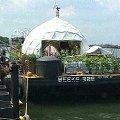It's known as the Waterpod, a kind of working farm at sea. It's on a barge docked at Staten Island, one of New York City's five boroughs. Photographer Mary Mattingly designed it as home and work place for five people. On the barge, they grow their own food. "We have a lot of fried green tomatoes these days. We have cucumbers, potatoes, pumpkins lots of lettuces, and kale," she explains, "Vegetables are grown here hydroponically, in nutrient solutions funneled through soil. This plant is expected to produce 50 tomatoes so we'll see how it goes." There are chickens on board too, not to eat, but for their eggs. "They are laying about 4 eggs a day," she said. The Waterpod has a small kitchen with a sink and a refrigerator. There are four cabins for sleeping, made from discarded wood.
"This paper that we are covering the wall with is from the set of 'As The World Turns' that soap opera," she states. Just about every structure on board was donated or recycled.
"This was from art crates," she says, "They packed paintings and were used once and then we recycled them from there." Even this chair is made from recycled material. "It's pretty nice," she says of the chair, "A nice way to relax on a hot day." This small community gets its water from rain. It has a pumping system to distribute it. The energy to run the pump comes from these solar panels.
If that fails, there are ways to charge batteries on this bicycle that can produce the electricity.
No one knows how long people could live here. But one thing is clear, visitors who come to look, want to try.
"I like how it rocks," one visitor says, "Rocks back and forth. Yeah I like that." "It sounds like an interesting life style," another visitor says, "I'd like to do it yeah." As for the barge itself, it's the costliest part of the project. But the rent is paid by public and private groups concerned with the environment.
Martin Phillips, VOA News, New York You can watch this video on YouTube : http://www.youtube.com/watch?v=-5BJAoWQs_I

